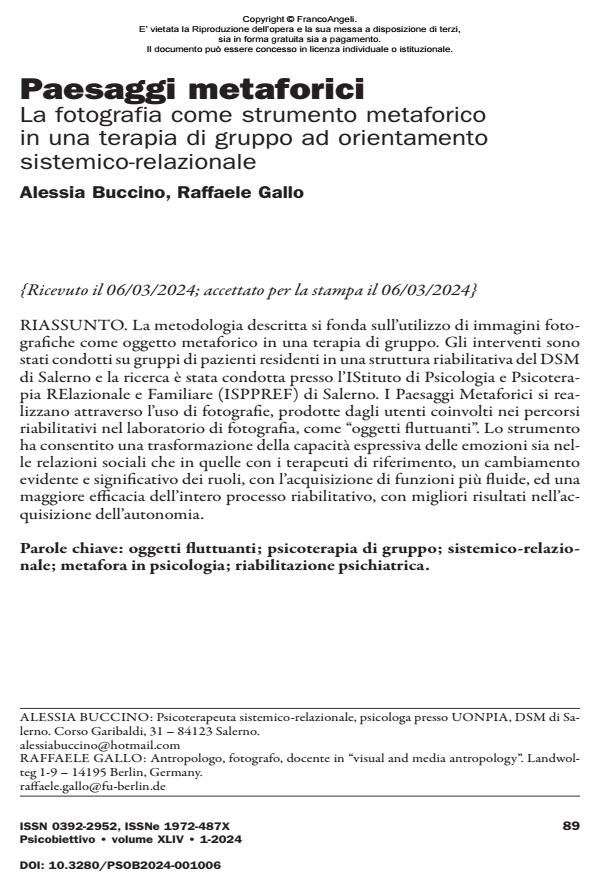Metaphorical Landscapes . Photography as a metaphorical tool in a group therapy with a systemic-relational approach
Journal title PSICOBIETTIVO
Author/s Alessia Buccino, Raffaele Gallo
Publishing Year 2024 Issue 2024/1
Language Italian Pages 14 P. 89-102 File size 158 KB
DOI 10.3280/PSOB2024-001006
DOI is like a bar code for intellectual property: to have more infomation
click here
Below, you can see the article first page
If you want to buy this article in PDF format, you can do it, following the instructions to buy download credits

FrancoAngeli is member of Publishers International Linking Association, Inc (PILA), a not-for-profit association which run the CrossRef service enabling links to and from online scholarly content.
The methodology described is based on the use of photographic images as a metaphorical object in group therapy. The interventions were conducted on groups of patients residing in a rehabilitation establishment of the Department of Mental Health in Salerno and the research was conducted at the Institute of Relational and Family Psychology and Psychotherapy (ISPPREF) in Salerno. The Metaphorical Landscapes are created through the use of photographs, produced by the patients involved in the rehabilitation programs in the photography laboratory, as “floating objects”. The tool has allowed a transformation of the expressive capacity of emotions both in social relationships and in those with the reference therapists, a clear and significant change in roles, with the acquisition of more fluid functions, and greater effectiveness of the entire rehabilitation process, with better results in the acquisition of autonomy.
Keywords: floating objects; group psychotherapy; systemic-relational; metaphor in psychology; psychiatric rehabilitation.
- Bateson G. (1972). Steps to an Ecology of Mind. Chandler Publishing Company, San Francisco (trad. it. di G. Longo, G. Trautteur, Verso un’ecologia della mente. Milano: Adelphi, 1977).
- Bateson G. (1984). Mente e natura, un’unità necessaria. Adelphi, Milano.
- Caillè P., Rey Y. (2005). Gli oggetti fluttuanti. Metodi di interviste sistematiche. Armando, Roma.
- Kuhn T. (1962). The Structure of Scientific Revolutions. Chicago: Chicago University Press (trad. it. della II ed. La struttura delle rivoluzioni scientifiche. Torino: Einaudi, 1979).
- Ellenberger H. (1976). Traduzione di F. Mazzone, La scoperta dell’inconscio. Bollati Boringhieri, Torino.
- Lotman Y. (1985). La semiosfera: asimmetria e il dialogo nelle strutture pensanti, a cura di Simonetta Salvestroni. Marsilio, Venezia.
- Lotman Y. (1990). Universe of the Mind: a Semiotic Theory of Culture. Trad. Ann Shukman, introduzione di Umberto Eco. Tauris, London.
- Morin E. (1974). L’unité de l’homme. Seuil, Paris.
- Morin E. (1977). La méthode. I. La nature de la nature. Paris (trad. it. di G. Bocchi,
- A. Serra, Il metodo. I: La natura della natura, Milano, 2001.
- Morin E. (1993). Introduzione al pensiero complesso. Trad. it. Sperling & Kupfer, Milano.
- Onnis L. (1985). Corpo e contesto. Terapia familiare dei disturbi psicosomatici. Carocci, Roma.
- Onnis L. (2005). Il tempo sospeso. Anoressia e bulimia tra individuo, famiglia e società. FrancoAngeli, Roma.
- Onnis L. (2017). Teatri di famiglia. La parola e la scena in terapia familiare. Bollati Boringhieri, Torino.
- Onnis L., Vietri A., Veglia A. (2008). Il problema delle emozioni nella psicoterapia sistemica. Idee in Psicoterapia, n. 2. Alpes Italia.
- Onnis L., Bernardini M., Leonelli A. Mulè A.M., Romano C., Vietri A. (2012). Les sculptures du temps familial. Une méthode de “narration analogique”. Cahiers critiques de thérapie familiale et de pratiques de réseaux, 1, n. 48: 31-57.
- Satir V. (1964). Conjoint Family Therapy, Science and Behavior Books. Palo Alto.
- Satir V. (1972). Peoplemaking, Science and Behavior Books. Palo Alto.
- Vietri A., Leonelli A., Mulè A.M. (2007). Contributo nel libro La mente nella ricerca. Attività scientifica in psichiatria e psicologia medica, di Massimo Biondi e Camillo Loriedo. FrancoAngeli, Roma.
- Vitebsky P. (1998). Gli sciamani. EDT, Milano.
Alessia Buccino, Raffaele Gallo, Paesaggi metaforici La fotografia come strumento metaforico in una terapia di gruppo ad orientamento sistemico-relazionale in "PSICOBIETTIVO" 1/2024, pp 89-102, DOI: 10.3280/PSOB2024-001006